#Amniota
Explore tagged Tumblr posts
Text

Anthracodromeus longipes was an early reptile* that lived in what is now Ohio, USA, during the late Carbonifeorus about 307-305 million years ago.
(*or possibly a very reptile-like stem-amniote)
Around 20cm in total length (~8"), it had a rather lizard-like shape with a long body and a short tail. The digits on all four of its limbs were highly elongated with hooked claws, which appears to have been an adaptation for climbing.
It inhabited a coal forest dominated by lycopsid trees and seed ferns, and as one of the earliest known tetrapods to develop climbing behavior it would have had some ecological advantages over its relatives, being better able to escape from predators and access new food sources.
———
NixIllustration.com | Tumblr | Patreon
References:
Carroll, R. L., and Baird, D. "Carboniferous stem-reptiles of the family Romeriidae." Bulletin of The Museum of Comparative Zoology 143 (1972): 321–363. https://archive.org/details/biostor-696/mode/2up
Mann, Arjan, et al. "Digit and ungual morphology suggest adaptations for scansoriality in the late Carboniferous eureptile Anthracodromeus longipes." Frontiers in Earth Science 9 (2021): 675337. https://doi.org/10.3389/feart.2021.675337
Simões, Tiago R., et al. "Successive climate crises in the deep past drove the early evolution and radiation of reptiles." Science Advances 8.33 (2022): eabq1898. https://doi.org/10.1126/sciadv.abq1898
Wikipedia contributors. “Anthracodromeus” Wikipedia, 09 Jun. 2024, https://en.wikipedia.org/wiki/Anthracodromeus
129 notes
·
View notes
Video
Munchique Wood-Wren by Jay Packer Via Flickr: Endemic to the western Andes of Colombia, this highly sought-after wood-wren is found at higher elevations than the similar Gray-breasted Wood-Wren. Montezuma Road, Tatamá National Park, Colombia
#Animalia#Amniota#Aves#Reptilia#Vertebrata#Archosauromorpha#Chordata#Diapsida#Tetrapoda#Munchique Wood-Wren#Colombia#Troglodytidae (Wrens)#Passeriformes#South America#Animals#Birds#Henicorhina negreti#flickr
12 notes
·
View notes
Text
A Prologue to Amniotes
Part IV - The egg came first
Late Mississippian. It has been 40 million years since tetrapods first walked on land. Every generation since then, they have remained bound to the waters for at least one moment in their life cycle.
Despite their adaptations for walking on land, early tetrapod reproduction wasn't much different from that of their fish predecessors. Spawning, or external fertilization of an egg mass, with eggs covered in a gelatinous membrane laid in a body of water, prevending the permeable eggs from dessicating.
But things are now changing. While the mid-Carboniferous rainforests still provide safe, moist environments, reptiliomorphs have already begun adventuring further inland. As swamps left room to humid crevices to lay eggs in, creatures like Casineria also began to develop internal fertilization, refusing to leave their reproduction at the mercy of the elements.
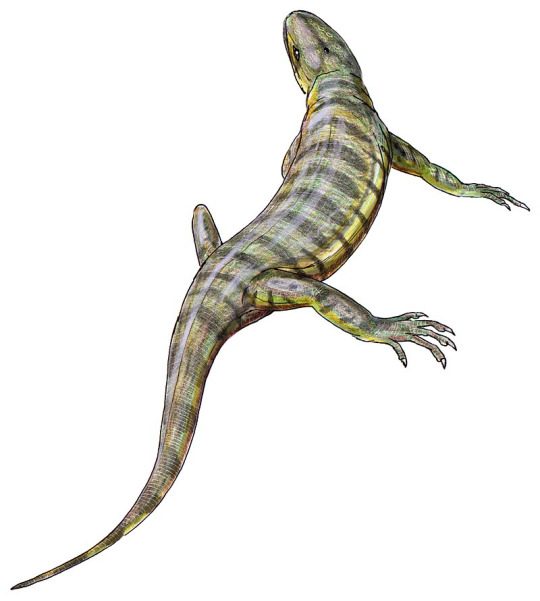
Casineria kiddi, an early amniote relative by ДиБгд (CC-BY-SA 4.0)
Adventuring into even drier environments, ancestors of amniotes still had to solve two crucial problems. While a harder shell could prevent the egg from dessicating, it would doom the embryo to suffocation, by preventing it to get rid of carbon dioxide. Furthermore, the small size of the eggs - also constrained by gas exchange - limited the full development of the embryo before hatching.
To solve both of these issues, the outer layers of the eggs would have to be reshaped. The outer gelatinous layer was replaced by a fibrous membrane for protection, and later by the three layers known as extraembryonic membranes: the amnion, chorion and allantois. The innermost amnion would surround and protect the embryo, while the outer chorion and sac-like allantois take care of gas exchange and waste removal.
In the safety of the amniotic egg, the embryo was able to hatch considerably more developed than before. Skipping the larval stage, amniote youngs would hatch as miniatures of the adults, making them able to face the challenges of the Carboniferous world from the day of their birth.

Structure of the amniotic egg, by Lumen Learning (CC-BY)
As the Pennsylvanian began and climate started to dry out, later developments would perfect the ability of early amniotes to survive in drier, fully terrestrial environments. A thicker, less permeable skin will develop, incorporating keratin and preventing dessication. Cutaneous respiration, requiring the skin to be moist at all times, will give way to costal respiration, harnessing the power of the ribcage to expand and contract the lungs. Cutting their last ties with the water, amniotes had finally conquered the land.
On one fateful day, not long after the amniote body plan was perfected, one of the most decisive splits in vertebrate history would occur. A divergence of the amniotes into two major lineages, alternating domination of land, sea and sky for the next 320 million years. But sauropsids like Hylonomus would at first stay in the shadows. The stage of the Late Pennsylvanian would be left to their rivals and cousins, as forerunners like Archaeothyris paved the way for their own lineage: the synapsids.
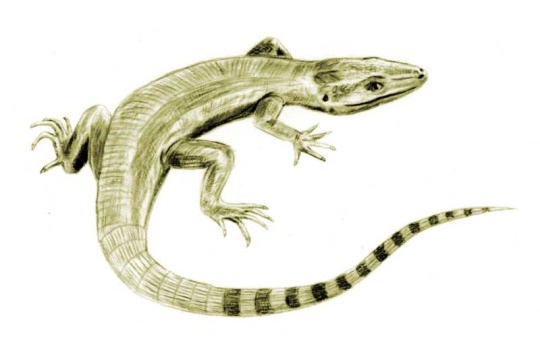
Archaeothyris, one of the first known synapsids, by ArthurWeasley (CC BY-SA 3.0)
15 notes
·
View notes
Text
found a decapitated wild rabbit in a neighbor’s yard, pics under the cut
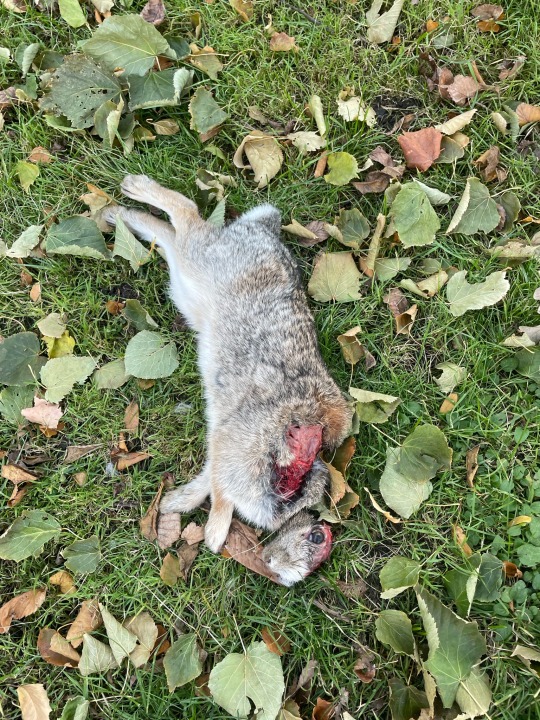
#chordata#sarcopterygii#tetrapoda#amniota#synapsida#mammalia#theria#eutheria#boreoeutheria#euarchontoglires#glires#lagomorpha#leporidae#ok that’s enough clades#won’t bother with all those in the future just having fun with them#oh also#animal death#that guy is super dead
0 notes
Text
New day, tree time!

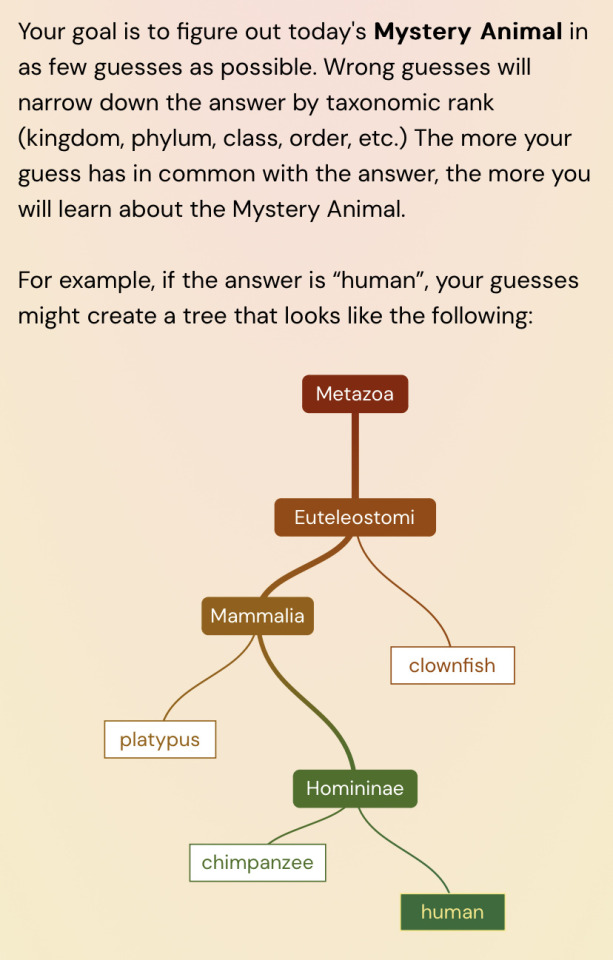
guys i just found out about this site that does a daily guessing game, it’s phylogenetic wordle- so fun!!!
30K notes
·
View notes
Note
Birds are class Aves.
Sure, under Linnaean taxonomy. But, well,
A) Linnaeus was a eugenecist so his scientific opinions are suspect and his morality is awful
B) he didn't know about evolution
C) he didn't know about prehistoric life
so his classification system? Sucks ass. It doesn't work anymore. It no longer reflects the diversity of life.
Instead, scientists - almost across the board, now - use Clades, or evolutionary relationships. No rankings, no hierarchies, just clades. It allows us to properly place prehistoric life, it removes our reliance on traits (which are almost always arbitrary) in classifying organisms, and allows us to communicate the history of life just by talking about their relationships.
So, for your own edification, here's the full classification of birds as we currently know it, from biggest to smallest:
Biota/Earth-Based Life
Archaeans
Proteoarchaeota
Asgardians (Eukaryomorphans)
Eukaryota (note: Proteobacteria were added to an asgardian Eukaryote to form mitochondria)
Amorphea
Obazoa
Opisthokonts
Holozoa
Filozoa
Choanozoa
Metazoa (Animals)
ParaHoxozoa (Hox genes show up)
Planulozoa
Bilateria (all bilateran animals)
Nephrozoa
Deuterostomia (Deuterostomes)
Chordata (Chordates)
Olfactores
Vertebrata (Vertebrates)
Gnathostomata (Jawed Vertebrates)
Eugnathostomata
Osteichthyes (Bony Vertebrates)
Sarcopterygii (Lobe-Finned Fish)
Rhipidistia
Tetrapodomorpha
Eotetrapodiformes
Elpistostegalia
Stegocephalia
Tetrapoda (Tetrapods)
Reptiliomorpha
Amniota (animals that lay amniotic eggs, or evolved from ones that did)
Sauropsida/Reptilia (reptiles sensu lato)
Eureptilia
Diapsida
Neodiapsida
Sauria (reptiles sensu stricto)
Archelosauria
Archosauromorpha
Crocopoda
Archosauriformes
Eucrocopoda
Crurotarsi
Archosauria
Avemetatarsalia (Bird-line Archosaurs, birds sensu lato)
Ornithodira (Appearance of feathers, warm bloodedness)
Dinosauromorpha
Dinosauriformes
Dracohors
Dinosauria (fully upright posture; All Dinosaurs)
Saurischia (bird like bones & lungs)
Eusaurischia
Theropoda (permanently bipedal group)
Neotheropoda
Averostra
Tetanurae
Orionides
Avetheropoda
Coelurosauria
Tyrannoraptora
Maniraptoromorpha
Neocoelurosauria
Maniraptoriformes (feathered wings on arms)
Maniraptora
Pennaraptora
Paraves (fully sized winges, probable flighted ancestor)
Avialae
Avebrevicauda
Pygostylia (bird tails)
Ornithothoraces
Euornithes (wing configuration like modern birds)
Ornithuromorpha
Ornithurae
Neornithes (modern birds, with fully modern bird beaks)
idk if this was a gotcha, trying to be helpful, or genuine confusion, but here you go.
all of this, ftr, is on wikipedia, and you could have looked it up yourself.
679 notes
·
View notes
Text
Fossil Friday: Lisowicia bojani
I am still geeking out over how far this animal made it during March Madness. Lisowicia bojani lived in Poland during the Late Triassic Period about 210-205 Ma. It was discovered in 2006 by Polish paleontologists Jerzy Dzik, Tomasz Sulej and Grzegorz Niedźwiedzki, who initially thought it was a sauropodomorph. I mean, can you blame them? This thing is HUGE. it wasn't officially named until 2019 though.
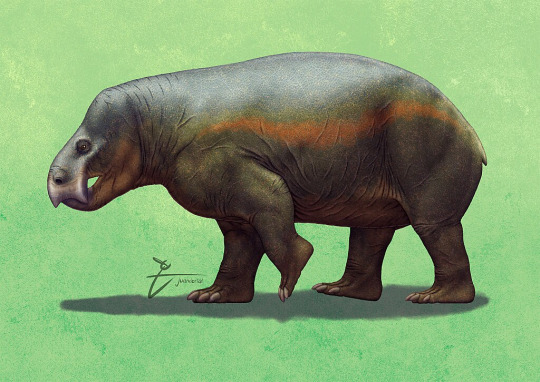
It was found in the Lipie Śląskie clay pit which consists mostly of green mudstones. It's home would have been wet and swampy, akin to the modern day Everglades with large meandering rivers, oxbow lakes and surrounded by abundant vegetation, mostly conifers, ferns, and cycads.
It lived alongside animals such as the archosaurs Smok (who was probably the apex predator),

a silesaurid, a small theropod dinosaur, pterosaurs, a small crocodylomorph, a sphenodont, primitive amphibians, lungfish, coelacanths, hybodontid sharks and a smaller synapsid called Hallautherium.
it belongs in the phylum Chordata (vertebrates) in the clade Amniota in the smaller Synapsida clade (animals with one pair of temporal fenestrae in their skull), continuing into the even smaller Therapsida clade (mammals and their closest relatives).

Within Therapsida, they belong to the suborder anomodontia in the clade dicynodontia.


Dicynodonts are a group of tusked, beaked herbivorous synapsids that ranged from the mid-Permian to the Late Triassic. Lisowicia was the largest of this highly successful group.
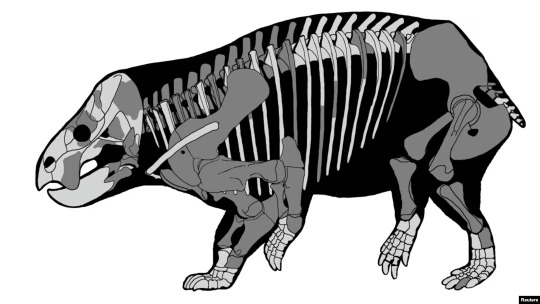
It had very large temporal fenestrae which allowed for large jaw muscles to attach at the back of the skull. It was a stocky animal like its closest relatives. It was completely toothless and lacked the tusks of other dicynodonts
It's cervical vertebrae have hollows excavated along the lateral sides but lack pleurocoels so their function is currently unknown.
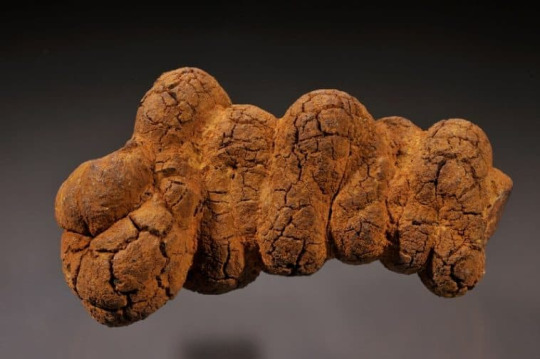
Coprolites attributed to Lisowicia have been found in abundant accumulations that have been interpreted as a sort of communal bathroom. It seems these animals could have been litter box trained! Within these coprolites have been found evidence of soft vegetation and conifers and occasionally woody material.

The bones of Lisowicia lack clear lines of arrested growth (LAGs) which might suggest that they grew very rapidly without interruptions until they reached adult size. LAGs may have either been absent or erased due to extensive remodeling of bone into adulthood which is similar to mammals and some dinosaurs. This would support permanently rapid growth.
Hope you enjoyed this week's lessons and I hope you tune in Monday to learn about another popular metal. Fossilize you later!
#paleontology#fossils#fun facts#science education#science#science side of tumblr#synapsid#dicynodont#march madness
16 notes
·
View notes
Note
the concept of evil
THE CONCEPT OF EVIL would NOT EXIST without CYANOBACTERIA
It is not possible for beings without an understanding of morality to be evil. Although different people have different theories about which organisms actually understand morality, you'll really never hear anyone claim that anything less closely related to us than a bird (usually its Corvids. Related through Amniota.) can understand morality.
No matter where you think the line is, if you're a reasonable person, you agree that everything capable of understanding morality also requires O2 to survive. Cyanobacteria are the ones who have created almost all of this O2. Therefore, nothing moral could exist without them, and neither would anything evil.
16 notes
·
View notes
Text





Alright here's the very first batch of alien animals we have, first 7 classes out of 120. Starting off with Superphylum Near Bilateral
(AN1) Clade: Nephrozoa
A clade of animals that possess a distinct oral and anal end during the first stage of development.
(AN1 A) Clade Bilatera
A clade of animals that are symmetrical on either side of the sagittal plane and retain their oral and anal ends throughout most of their lifetime.
Superphylum Near Bilateral
A taxa of animals possessing a solidified nerve structure or adjacent notochord-analogous structure in the initial stage of development; occupying terrestrial or the upper stratification of the aquatic biosphere.
(AN1 A1) Clade Quasichordata
A clade of near bilaterans that possess a dorsal fibrous nerve column functionally similar to a notochord at some point in their life cycle.
PHYLUM ENDOSPINAL CHORDATA
Phylum contains a notochord at some point in the life cycle, with an internal dense skeleton made typically of bone or cartilage. Gametangia positioned posterior to abdominal tagma. Dermal protection by mucus membrane or keratin.
(AN1 A1-a) Clade Amniota
Clade using amniotic fluid to support, protect, and provide nutrients to embryos.
(AN1 A1-ai) Clade Reptilia (Includes Mammalian Reptiles and Non-Mammalian Reptiles)
Clade of amniotes that possess an outer dermal layer of scale plates, a mineralized skeleton of bone, defense structures of keratin, and a coccyx that extends into a posterior tail.
Class Mammalian Reptiles
Class of reptiles that maintain heat through endothermy, give live birth to young, possess mammary glands, and typically dual integumentation.
Class Non-Mammalian Reptiles
Class of reptiles that maintain heat through exothermy, develop young through eggs, possess yolk inside eggs, and typically have single integumentation.
(AN1 A1-aii) Clade Membrana (Includes Membranous Dermates)
Clade of amniotes that possess an outer dermal layer of mucosal membrane, an internal skeleton of cartilage, and an internal circulation structure consisting of a hemocoel.
Class Membranous Dermates
Class of membranes that develop only an outer mucus membrane for protection and do not use shells or rocks to protect themselves.
(AN1 A1-aiii) Clade Pescada (Includes Cartilage Fish and Bone Fish)
Clade of amniotes that possess an outer dermal layer of keratin scales and a passive respiration through gills.
Class Cartilage Fish
Class of pescada that have an internal skeleton of cartilage and do not have fixed jaws.
Class Bone Fish
Class of pescada that have an internal skeleton of bone and have fixed jaws.
(AN1 A1-b) Clade Cephalopoda (Includes Cephalopodal)
Clade using a mucosal sac to house embryos and transfer from a polyp to a medusoid stage.
Class Cephalopodal
Class using a mucus membrane, a ringed oral and anal end, and six dense muscled tentacles for movement.
(AN1 A1-c) Clade Oothecae (Includes Exoskeletal Endoskeletal)
Clade using ootheca ovoviviparity which detaches before maturity.
Class Exoskeletal Endoskeletal
Class utilizing both an internal mineralized skeleton in tandem with a dense plated mineralized exoskeleton.
#art#digital art#artists on tumblr#worldbuilding#jomgol#spec bio#spec evo#speculative biology#speculative evolution#xenobiology#speculative zoology#speculative worldbuilding
13 notes
·
View notes
Text
50 metazooa win (53 games)
one of the funnier trees/series of guesses
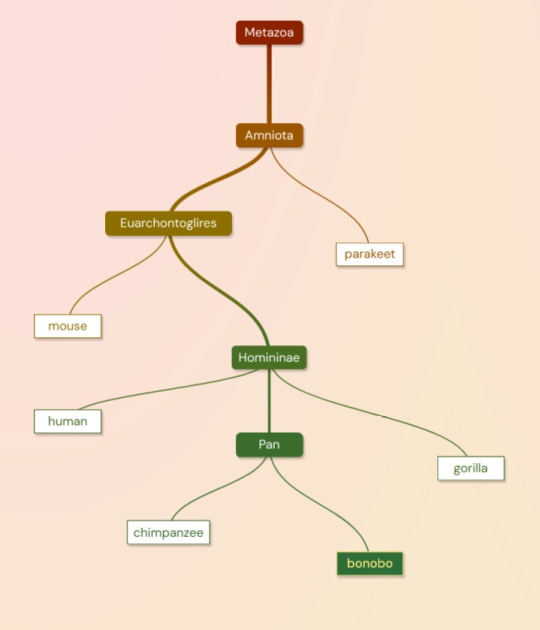
[ID: The metazooa, a cladistics puzzle tree, guessed in 6. Starting with parakett under amniota, then mouse under euarchontoglires. Under homininae is human then gorilla. And finally under pan is chimpanzee then the answer, bonobo. END]
like. they did some monty hall shit to me
Pan (genus)
The genus Pan consists of two extant species: the chimpanzee and the bonobo. Taxonomically, these two ape species are collectively termed panins.
good on me for specificity? completionism?
8 notes
·
View notes
Text
Introduction
Hi! You can call me void, my pronouns are they/them. I wanted to make a short intro to tell you what this blog is about.
If you don't know, metazooa is a game where you have to guess the animal of the day, by going through a tree where each guess tells you the closest common groups between the animals (eg: Laurasiatheria, Amniota). I decided to make this blog, somewhat inspired by the art everyday accounts i've seen on here, where I will draw the animal of the day hopefully everyday if I can. I will also share my score of the day, using the format m[total amount of guesses]/[amount of mistakes] (eg: m6/2). The posts will likely be made towards the end of the day (GMT) as to avoid spoiling the answer for anyone.
I hope anyone who finds this blog and follows along enjoys the journey, and that you have a good rest of your day/night.
-Void
3 notes
·
View notes
Text
HTTYD: Dragon Taxonomy
Kingdom: Animalia
Phylum: Chordata
Clade: Amniota
Clade: Synapsida
Clade: Therapsida
Clade: Dercomaiia
Clade: Draconomorpha
Class: Dracontes
Superorders: 2
Orders: 8
Families: 26
Superorder
Order
Family
Gronckle
Hotburple
Quaken
Goregutter
Red Death
Bewilderbeast
Cavern Crasher
Family
Eruptodon
Sentinel
/
Order
Family
Mudraker
Thunderclaw
Family
Snow Wraith
Snifflehunch
Windgnasher
Family
Snafflefang
Shovelhelm
Moldruffle
/
Order
Family
Hideous Zippleback
Scauldron
Family
Hobgobbler
Submaripper
Family
Buffalord
/
Order
Family
Night Fury
Light Fury
Sand Wraith
Woolly Howl
Family
Stormcutter
/
Order
Family
Thunderdrum
Shellfire
Family
Singetail
Smothering Smokebreath
Changewing
Snaptrapper
/
Order
Family
Flightmare
Sweet Death
Shockjaw
Firewyrm
Thunderpede
Flame Whipper
Family
Shadow Wing
Family
Sandbuster
Slitherwing
Family
Grapple Grounder
Grim Gnasher
Family
Egg Biter
Deadly Nadder
Scuttleclaw
Family
Dramillion
Family
Rumblehorn
Triple Stryke
Deathgripper
/
Superorder
Order
Family
Razorwhip
Windstriker
Death Song
Slithersong
Family
Devilish Dervish
Thornridge
Threadtail
Family
Monstrous Nightmare
Armorwing
Boneknapper
Night/Cave/Fire Terror
Prickleboggle
Terrible Terror
Family
Typhoomerang
Silver Phantom
Timberjack
/
Order
Family
Sword Stealer
Shivertooth
Windwalker
Groncicle
Hackatoo
Seashocker
Family
Hobblegrunt
Skrill
Whispering Death
Screaming Death
Family
Raincutter
Sliquifier
Tide Glider
Speed Stinger
5 notes
·
View notes
Video
Green-and-black Fruiteater by Jay Packer Via Flickr: Reserva Ecológica Río Blanco, Colombia
#Animalia#Amniota#Aves#Cotingidae (Cotingas)#Vertebrata#Archosauromorpha#Chordata#Reptilia#Tetrapoda#Diapsida#Colombia#Green-and-black Fruiteater#Passeriformes#South America#Animals#Birds#Pipreola riefferii#flickr
7 notes
·
View notes
Text
Verts Lecture 1 Review for Test 3
Hey guys its been a while since I last posted but I am studying for my exam that is on monday so I am gonna HOPEFULLY make some posts to study
Here is the first lecture content for exam 3
Major Groups of Craniata:
Vertebrata, Gnathostomata, Osteichthyes, Sarcopterygii, Tetrapoda, Amniota, Sauropsida, Diapsida, Archosauria
Characteristics of Amniota
Amniotic Egg
Costal Ventilation of Lungs
Impermeable Skin
Temporal Fenestration
Geological Time Scale

Characteristics of Archosauria
Antorbital Fenestra
An extra fenestra hole in front of the eye
Shape of the orbit
Not a circular shape, more of a teardrop shape
Teeth
Sharp fangs
Bipedalism
Ability to walk on two legs
Fourth Trochanter
A part of the bone that sticks out on the femur for muscle attachment which allows for quicker bipedal running
Characteristics of Crocodilians
nostrils on tip of snout
allows them to breathe while mostly submerged in water for hiding and idle hunting
Secondary palate separates mouth from nasal passages
Humans also have this! it separates air from food and water and also allows them to hold prey under water while also breathing through their nostrils.
Flap of tissue at base of tongue can seal mouth and throat from water
allows them to close off their throat while they dive under water so no water is breathed into lungs. this is important for eating underwater.
depressor mandibulae
short WEAK muscle that opens the mouth. crocodiles have a powerful bite, but once that mouth is closed it is difficult for them to open it again. it is weak because the closing muscles are a lot stronger
ventricular septum in the heart
wall that separates chambers of heart. allows them to control where they send blood when it is needed more in certain places
hunt in water
ectotherms
temperature is controlled outside of body
Parental care
help young out of eggs
young stay with parents for years
Differences in heart in crocodilians
4 chambered, but one aorta from each ventricle are connected by foramen of panizza
foramen of panizza
opening that allows for mixing of oxygen rich blood and oxygen poor blood for fast oxygen use when needed
Blood flow patterns
Resting:
croc is just hanging out. oxygen rich blood comes from the lungs and is sent to the body and then sent back to lungs as oxygen poor to gain more o2. very similar to humans/mammals
Activity:
when hunting or moving a croc needs oxygen fast, so they will often mix a bit of oxygen rich blood with oxygen poor blood and send that through the body to boost them with short bursts of energy
Diving/Thermoregulation:
when they stay underwater for a long time, lungs arent bringing in any more oxygen. they use the foramen of panizza to mix together oxygen rich and oxygen poor blood and then "shunt" it through the body. they do not send any blood to the lungs since oxygen isnt coming in and they instead use that all for staying under as long as possible
Groups of Dinosaurs
Ornithischia and Saurischia
Both bipedal, legs splayed directly under body
Ornithischia
all extinct, herbivorous, diverse morphological forms, many had cheeks and horny beaks rather than teeth
a. Thyreophora - armored dinosaurs
b. Ornithopoda - duck-billed dinosaurs
c. Marginocephalia - pachycephalosaurs
Saurischia
a. Sauropodomorpha - brontosaurus
b. Theropodomorpha - trex
0 notes
Text
Pachydectes es un género extinto de terápsidos perteneciente a la familia Burnetiidae y al suborden Biarmosuchia, que vivió durante el Pérmico Medio en lo que hoy es Sudáfrica.

Se conoce a partir de un único cráneo parcial sin mandíbula (holotipo BP/1/5735), el cual mide aproximadamente 35 cm de longitud. Basándose en este tamaño craneal, se estima que el animal completo podría haber alcanzado los dos metros de longitud. Su fósil fue hallado en la Formación Koonap, una unidad geológica que data de esta misma época y que ha proporcionado importantes hallazgos de vertebrados terrestres primitivos.
Biarmosuchia: Un Vínculo entre Pelicosaurios y Terápsidos
Los biarmosuquios (Biarmosuchia) representan un suborden de terápsidos primitivos que jugaron un papel clave en la evolución de los sinápsidos. Se consideran una forma intermedia entre los pelicosaurios esfenacodóntidos y los terápsidos más avanzados, que eventualmente dieron origen a los mamíferos. Eran animales de tamaño mediano, en su mayoría carnívoros, con adaptaciones craneales que evidencian una mordida más poderosa en comparación con sus ancestros más primitivos.
El cráneo de los biarmosuquios es similar al de los esfenacodóntidos, pero con ciertas diferencias clave: una fenestra temporal más grande, una inclinación del occipucio hacia atrás, una reducción en el número de dientes y la presencia de un único diente canino en ambas mandíbulas. La prominencia en la parte posterior del cráneo sugiere la presencia de músculos mandibulares grandes, lo que implicaría una mordida fuerte y eficiente para su dieta carnívora.
Distribución y Evolución
Los biarmosúquidos han sido encontrados en diversas regiones del mundo, principalmente en Rusia y Sudáfrica. Géneros como Phthinosuchus, Biarmosuchus y Eotitanosuchus han sido hallados en depósitos pérmicos de Rusia, mientras que en Sudáfrica se han identificado familias como Ictidorhinidae y Burnetiidae, a la cual pertenece Pachydectes. Su rango temporal abarca desde el Pérmico Medio hasta el Pérmico Superior, justo antes de la gran extinción masiva que marcaría el final de esta era.
El Pérmico y el Fin de una Era
El Pérmico es el último período de la Era Paleozoica, iniciando hace aproximadamente 299 millones de años y terminando hace unos 251 millones de años con la extinción masiva del Pérmico-Triásico. Durante esta época, los primeros amniotas se diversificaron en grupos ancestrales que darían origen a los mamíferos, tortugas, lepidosaurios y arcosaurios. El mundo estaba dominado por el supercontinente Pangea y el océano Panthalassa, en un contexto de importantes cambios climáticos que llevaron a la progresiva aridez de muchas regiones.
La extinción del Pérmico-Triásico fue la más devastadora en la historia de la Tierra, eliminando aproximadamente el 81% de las especies marinas y el 70% de las especies terrestres. Este evento marcó la desaparición de muchos grupos de organismos, incluyendo trilobites y ciertos grupos de terápsidos, abriendo paso a la diversificación de los arcosaurios en el Mesozoico.
Conclusión
Pachydectes representa un interesante ejemplo de la diversidad de los terápsidos en el Pérmico Medio y la evolución de los biarmosuquios. Como miembro de los Burnetiidae, proporciona pistas sobre la transición de los sinápsidos tempranos hacia formas más especializadas. Aunque su registro fósil es limitado, su hallazgo en la Formación Koonap nos ayuda a comprender mejor la fauna de esta época y el papel de los biarmosuquios en los ecosistemas terrestres previos a la gran extinción pérmica
0 notes
Text
yes, I know wikipedia says "reptilia" is a subset of sauropsida, but that is hardly a consensus/universal agreement. Plus, this is a silly tumblr poll, and I enjoy silliness. (Including an option does not mean I endorse it). Some pros and cons are below. don't worry, I plan on doing this for other holdover linnean names folks can't let go of - fish, amphibian, bird, mammal, bug...
Pro to Reptiliomorpha: no way you're leaving anything out Con to Reptiliomorpha:
Pro to Amniota: "mammal-like reptile" stays Con to Amniota: it is absolute madness to consider mammals reptiles, that is such a deep divergence
Pro to Sauropsida: mammals are left out, as are all synapsids, but most things called reptiles stay in (as do birds) Con to Sauropsida: people will still call Dimetrodon a reptile and we will never know peace
Pro to Eureptilia: excluding parareptiles which are just weird enough that you could do it Con to Eureptilia: it's somewhat arbitrary and excludes a bunch of things we'd call reptiles today
Pro to Diapsida: being a diapsid is usually considered a major feature of reptiles, esp now we know turtles evolved from diapsids Con to Diapsida: it's somewhat arbitrary and excludes a bunch of things we'd call reptiles today
Pro to Sauria: crown group of living reptiles Con to Sauria: ichthyosaurs (maybe) & a bunch of other reptile like things are excluded
Pro to Lepidosauromorpha: birds aren't called reptiles Con to Lepidosauromorpha: crocodiles, turtles, pterosaurs, nonavian dinosaurs, and many more aren't reptiles
#reptiles#palaeoblr#taxonomy#animals#herpetofauna#I do this to sow chaos#and wait for my beta readers to get back on chapter one#and avoid doing my research#don't tell my advisor
133 notes
·
View notes